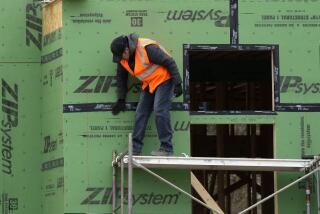Wage Report Shows Moderate Gains; Benefit Costs Are Steady
- Share via
WASHINGTON — Wages and benefits for U.S. workers rose at a moderate 0.8% rate in the second quarter, the Labor Department reported Tuesday, indicating that labor costs for U.S. corporations remain fairly well-contained despite strong economic growth.
The report, which showed the “employment cost index” of total compensation rising at a 2.9% rate during the 12 months ended June 30, was good news for the Clinton administration, as was another report showing that consumer confidence shot up in July to a six-year high. The administration is trumpeting its stewardship of a healthy economy with low inflation.
Coming amid jitters in financial markets about the likelihood that inflation could be rekindling, “the figures are somewhat comforting,” said Cynthia Latta, an economist with DRI/McGraw-Hill. “There’s not as much acceleration of employment costs as we had feared there might be.”
Financial markets reacted with cautious optimism to the report, as stocks rose and bond yields eased.
The report on the employment cost index, or ECI, a closely watched indicator of future pressure on compensation and prices in general, by itself would decrease the chance that the Federal Reserve Board will tighten credit at its next policy meeting on Aug. 20, analysts said.
But Ray Stone, economist with Stone & McCarthy Research in Princeton, N.J., noted that “we have a lot of pretty important economic statistics that are going to be released this week,” including both the July employment report and the growth in second-quarter gross domestic product.
According to the Labor Department report, wages and salaries rose 0.9% during the second quarter after increasing 1.0% in the first quarter. Additionally, benefit costs rose 0.7% in the second quarter after showing no change in the previous quarter.
Overall, benefit costs continue to grow only slowly: The ECI report showed a 1.7% rise in benefit costs for private workers in the 12 months ended June 30, down from a 2.2% rise in calendar 1995.
The report showed that private industry workers are making out better than those in government, especially on the wage front. Wages and salaries of private workers rose 3.4% in the 12 months ended June 30, the biggest jump in more than four years.
“There’s an upward trend in wage increases, but it’s a gentle trend, not a virulent one,” said Richard Berner, chief economist at Pittsburgh-based Mellon Bank.
Separately, the Conference Board reported Tuesday that its index of consumer confidence rose to 107.2 in July, a gain of more than 7 points over June, underscoring the public’s general satisfaction with economic prospects. The index now stands at the highest level since May 1990.
In yet another report welcomed by economists as a sign the economy isn’t overheating, home sales dropped 5.3% in June, the Commerce Department said. Analysts said the drop was probably caused by higher mortgage rates cooling the housing market. The June decline followed a sharply revised 1.2% increase in May, which had originally been reported as a 7.5% increase.
The National Assn. of Business Economists, meanwhile, issued a report offering conflicting data on the inflation outlook.
On one hand, more than 50% of the firms in the survey reported inventory shortages of some sort--a sign that manufacturing capacity is being stretched. It was the first time since 1988 that a majority did so.
On the other hand, fewer firms reported rising product prices than they did in the first quarter, and more reported falling prices.
(BEGIN TEXT OF INFOBOX / INFOGRAPHIC)
Consumer Confidence
From a monthly survey of 5,000 U.S. households. Index; 1985 = 100
July: 107.2
Source: Conference Board
More to Read
Inside the business of entertainment
The Wide Shot brings you news, analysis and insights on everything from streaming wars to production — and what it all means for the future.
You may occasionally receive promotional content from the Los Angeles Times.










